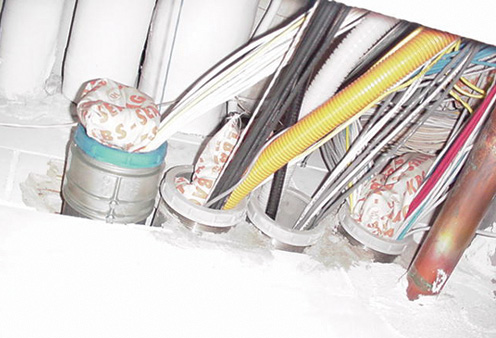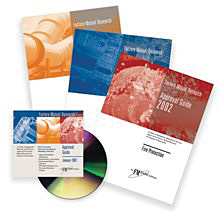Setting the Standards
Construction quality has been under close scrutiny for several years domestically. There have been several articles on construction process quality in Engineering News Record, in Construction Specifier magazine and other publications.
To provide a construction process installation protocol, the Firestop Contractors International Association (FCIA) created three standards in an attempt to bring the manufacturing quality process to the construction subcontracting industry. The standards developed were FM 4991, Standard for the Approval of Firestopping Contractors; and ASTM E2174 and E2393, Standards for the Inspection of Installed Penetration and Joint Firestop Systems.
FM 4991, also in MasterSpec and SpecLink master specification packages, is a way to measurably qualify a specialty firestop contractor’s quality process through an independent audit verification program. The FM 4991 standard is an approval of the firestop contracting firm, as the firm controls training, education, installation, submittal and the complete process. The standard requires that a contractor firm have a designated responsible individual (DRI). The DRI will have successfully passed an industry test based on the FCIA Firestop Industry Manual of Practice, rigorously tested systems selection from Underwriters Laboratories, Omega Point, FM and Warnock Hersey International directories, and the FM 4991 standard. This designation quantifiably measures an individual’s knowledge of industry quality procedures. The FM 4991 DRI manages the firestop contracting firms’ processes to be sure policies and procedures result in installed firestop systems that meet the tested and listed system requirements.
During the FM 4991 approval process, an FM Approvals auditor visits the firm, audits the clients’ quality manual, and then checks the installed firestop system in the field through destructive testing to verify the paperwork’s validity. FM Approvals performs annual follow-up audits with the same destructive testing. This program, although modeled after manufacturing firms’ ISO 9000 process, is customized to the construction industry, making the program workable in our industry. The FM 4991 program approval is quite affordable for a specialty firestopping subcontractor. The cost is about $4,000 to $6,500 for the initial audit, and approximately $1,500 per year for the follow-up audits. Most contractors spend in excess of $4,500 for a Blue Book ad, and $1,500 could be a small group entertainment expense. With the FM 4991 program, the firm is able to take an objective look at its operating procedures for both quality and efficiency.
Effective quality programs have a procedure for production and sampling to be sure the process works. Independent firestopping inspections to ASTM E2174 and E2393 are the controls that test the production process for firestop installation.
These inspection standards incorporate the following important points as part of the inspection protocol:
- Independence–The inspection firm must not be related to the installing firm, or be a distributor or manufacturer supplier to the firm.
- Pre-project meeting–The standard calls for a pre-job meeting with those installing firestopping in order to review the protocol and discover potential difficulties before the project commences.
- Mock-ups–These are constructed to give a benchmark to install to and inspect against.
- Sampling–The protocol calls for either ongoing inspection of 10 percent of each type of each firestop assembly or 2 percent destructive testing. Both types require one of each type of firestop be reviewed. Should variances occur at a rate greater than the 10 percent allowed, the inspector is to stop work, notify the contractor and return at a later date after the contractor has corrected the work.
- Reports–The inspection firms report on variances and successes, based on forms in ASTM E2174 and E2393. This documentation, in addition to the as-built firestop system detailed drawings (from either testing laboratories or engineering judgment-or equivalent fire-resistance rated assemblies) becomes the complete firestop system document for the life-cycle, including maintenance and alterations.
The ASTM E2174 and E2393, Standards for On-Site Inspection of Installed Fire Stops in Penetrations and Joints, originated from the "quality process" approach. They are designed to be part of the total quality protocol needed for zero-tolerance firestop systems installation. Firestop manufacturers test their products for fire, temperature, smoke and water resistance; manufacture to strict product stewardship; and list systems suitable for use as firestop systems in the Underwriters Laboratories, Omega Point, Warnock Hersey International and FM Approvals directories. Independent inspection is a key element in the total quality process of firestopping in conjunction with FM 4991-approved contractors.
The question often arises, if there’s inspection, why do we need to use a specialty firestop or FM 4991-approved contractor? If we buy into the quality process as being part of the total cost of the installation, then the firm’s qualifications, efficiency and inspection pieces are linked. If firestopping work is awarded to several trades, inspection costs typically rise due to the coordination required by multiple trips and several different trades to inspect. With a single-source firestopping contractor, the inspector only has one firm to find on the job site, regardless of what penetrations or joints are in the building. With several trades installing firestopping, the continual attempt to find a responsible individual from each firm to escort the inspector to construction areas means exponentional time increases. The cost savings for inspection of a single firm are apparent.
Standards from ASTM E2174 and E2393 and FM 4991 are a package in the Firestopping Quality Process. Together with an FM 4991-approved specialty firestop contracting firm, the quality process cost is determined by the sum of both parts. ASTM E2174 can be used without a specialty firestop contractor or an FM 4991-approved firestop contractor on projects that use the "he who pokes hole fills it" protocol. However, the inspection will cost much more for the multiple-trade method, as it’s difficult to manage anywhere from two to 40 subcontractor firms that touch effective compartmentation with their penetrating pipes, ducts, cables, etc. Inspectors tell FCIA that the inspection costs rise dramatically due to multiple trades involved and submittal package variances to field applications that can be staggering, even with the more than 5,000 tested systems in the UL Book.
The lesson gained is: Use the Firestopping Quality Process. Tested and listed firestop systems made by quality manufacturers, installed by a specialty firestop contractor or FM 4991-approved contractor, inspected to ASTM E2174 and E2393 Standards, maintained to FCIA maintenance protocol, make the total quality management process complete.
 Figure 1
Figure 1
An example of cable penetrations, sealed improperly. They should be installed by specialty firestop contractors with specialized knowledge.
 Figure 2
Figure 2
FM 4991 contractors are listed in FM directories, and at www.fcia.org.
